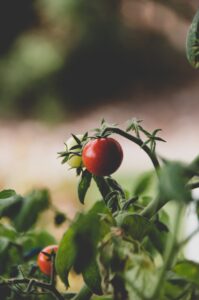 What is wrong with my tomatoes??
What is wrong with my tomatoes??
Most vegetable gardeners love to grow tomatoes in their garden. Nothing tastes better than a juicy red tomato straight from your own backyard. Generally, they are one of the easier vegetable plants to grow in your garden, however they do have quite a few pests and disease issues that you might encounter.
One of the most common issues we see is blossom end rot (BER). This issue begins as a tan lesion on the blossom end of the fruit, that eventually turns black. This is not a pest or disease, but it caused by a combination of either hot or cold temperatures during blossom set, and fluctuations in watering. These conditions cause calcium to become unavailable to the plant, causing the lesions. To manage BER, water and fertilize consistently and use mulch to help prevent moisture fluctuations.
Sunscald is another environmental issue that happens when the fruit is exposed to too much sun. If a hornworm has eaten a lot of the leaves off your plant, this might be more likely to happen. Use a shade cloth to reduce the amount of sunlight the fruits are exposed to.
Flea beetles might be a pest you could experience on your tomatoes and other vegetable plants. They are small black beetles that jump. They chew small holes in the leaves of the plants. Most healthy plants will survive a small to moderate flea beetle infestation, but if you need to resort to drastic measures, you can look for insecticides such as carbaryl or permethrin (be sure to read the label carefully).
A much larger insect you could encounter is a tomato hornworm. They are large green caterpillars with white markings on their side. They will demolish the leaves and unripe fruit of your plant, so you will want to hand pick them from the leaves as soon as you see them.
Fusarium wilt is a common tomato fungus that causes older leaves to yellow. Overwatering and underwatering also cause this symptom so make sure that your watering is correct before jumping to this conclusion. If you cut an infected plant at a lower stem, you will see it has brown discoloration in the vascular system. There isn’t a good control for this fungus, you will have to remove the plants. Don’t plant tomatoes, peppers, eggplants, or potatoes in the affected area for two to three years after discovering it.
Early blight is a fungus that will start to show up in the hotter months. It produces brown and black spots on older leaves. Leaves will eventually drop. Clean up all diseased leaves that fall to prevent spread (don’t compost them). Avoid overhead irrigation and prune to increase air circulation. You can also try a sulfur dust to protect leaves that have not yet been infected. You won’t want to plant tomatoes in the same spot next year.


